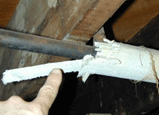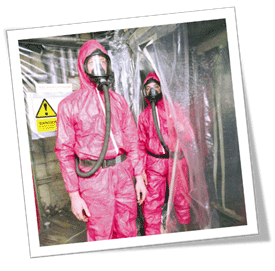Asbestos – Should Britain introduce an eradication law?
An All-Party Parliamentary Group on Occupational Safety and Health has published a paper that calls for the government to introduce an asbestos eradication law.
It concedes that most of the deaths from asbestos-related diseases were caused by exposure to the fibres many years ago. However, it states that as long as the material is in buildings, the risk of exposure exists and, as a result, deaths will continue for many years to come.
So this week I thought I’d look at this new proposal and consider the likelihood of it becoming law.
The two HSE cases this week both look at tragic accidents that shouldn’t have happened
- Simon Brook had his legs partially severed inside the machine and had to be amputated by a doctor at the scene. The 50-year-old father of six died two days later.
- Chromalloy UK Limited failed to properly manage the risk of bacteria growing in their cooling towers for over a year, from May 2011.
As ever, if you have a subject that you would like us to cover one week, please contact us by phone 01458 253682, email or via our Facebook page or by Twitter.
The Wilkins Safety Group are pleased to announce that we have been formally approved as an APS Registered Practice under the new categories of ‘Principal Designer’ and ‘CDM Adviser’ and that we are recognised as such on the Safety Schemes In Procurement (SSIP) portal.


Asbestos – Should Britain introduce an eradication law?
The All-Party Parliamentary Group on Occupational Safety and Health believes that the time has come to put in place regulations requiring the safe, phased and planned removal of all the asbestos that still remains in place across Britain.
The background
This year, in Britain, official figures estimate that 5,000 people are likely to die prematurely as a result of asbestos exposure. This is around three times the number of road accident deaths.
Almost all of the people who are dying now were exposed to asbestos decades ago and asbestos is now often wrongly seen as being a problem of the past, as its importation and use has been banned since 1999.
However asbestos is still with us and it is still as dangerous as ever. Asbestos Containing Materials (ACMs) can be found in around half a million non-domestic premises (and probably around a million domestic ones). It is present in a range of different forms including lagging on pipes and boilers; sprayed asbestos on pipes and in voids; asbestos cement in the form of roofing, wall cladding, guttering, pipes, water tanks and corrugated sheets, insulating boards, tiling, textured wall coatings, and asbestos ropes and cloth. Often it is either hidden or has not been identified as asbestos.
This means that people are still being exposed to asbestos. It is often people who are working in maintenance, refurbishment or demolition, but people can, and do, become exposed simply by working in a building with asbestos, as fibres can become dislodged and breathed in.
How dangerous is asbestos?
There are several different fatal diseases that result from asbestos exposure. The main ones are lung cancer, mesothelioma (which is a cancer of the lining of the lung or the abdominal cavity) and asbestosis, a long-term lung condition. 
There is estimated to be around 2,000 lung cancer deaths a year caused by asbestos exposure, although many campaigners believe that this is an underestimation. This is primarily considered to be a result of very high levels of exposure involved in activities such as asbestos spraying, lagging, etc. Most of this kind of work was stopped in Britain by the 1980s, and the figures from lung cancer are slowly decreasing.
However deaths from mesothelioma, which can result from much lower exposure, continue to increase and in 2013 led to 2,538 deaths. Fatalities from asbestosis are also increasing. In 2012 there were 464 deaths where asbestosis is likely to have contributed as a cause and 900 newly assessed cases for Industrial Injuries Disablement Benefit in 2013.
 An analysis of mesothelioma deaths shows that they are far more common amongst occupations such as carpenters, plumbers and electricians, but also occur amongst other workers with no history of work in the construction-related sector but who are likely to be effected through exposure in their workplace. This includes shopworkers, health-care workers, telephone engineers, teachers and finance workers.
An analysis of mesothelioma deaths shows that they are far more common amongst occupations such as carpenters, plumbers and electricians, but also occur amongst other workers with no history of work in the construction-related sector but who are likely to be effected through exposure in their workplace. This includes shopworkers, health-care workers, telephone engineers, teachers and finance workers.
Around 85% of mesothelioma deaths are a result of exposure at work, but some are due to exposure in the home. An unknown number of people may have developed mesothelioma as a result of exposure while at school. This is because asbestos is present in around 75% of schools.
There is no safe threshold of exposure to asbestos fibres. This means that the inhalation of small quantities, even over a short period, can lead to mesothelioma decades after exposure.
The Health and Safety Executive estimates that the number of deaths from mesothelioma is likely to continue to increase until around 2020 and then decline. This is because mesothelioma normally has a latency period of around 30-40 years and most exposure would have happened prior to the introduction of regulations restricting asbestos exposure and use in the 1970s and 1980s.
Before the death rate declines, around a quarter of a million people in Britain will have died as a result of asbestos exposure. How many will die after that is dependent on what we do now. Unfortunately the estimates of a decline after 2020 depend on presumptions of exposure which, the HSE admits, “are particularly dependent on assumptions about certain model parameters for which there is no strong empirical basis – and in particular, the extent of population asbestos exposure after 1980.”
Yet, there are no accurate figures for the levels of asbestos exposure since 1980, or any reason to believe that exposure will decline considerably over the coming decades unless action is taken to remove the cause of asbestos related diseases, which is the presence of asbestos containing materials.
So what is the present legal position?
The first major controls of asbestos were introduced in 1931, but only covered asbestos manufacturing processes.
In 1970 new regulations came into effect that covered other factories that used asbestos, including power stations and warehouses. It required better cleaning and the use of protective clothing.
In 1985 some types of asbestos were banned from importation or use and further regulations were introduced 2 years later. By 1988 most of the processes that led to very heavy exposure, such as spraying, were banned, and the use of asbestos as a major building material ceased.
The import, supply and use of almost all asbestos was not banned until 1999. However there were still considerable amounts of asbestos out there and people were being regularly exposed.
From 2004 there was a specific duty on employers to manage existing asbestos, and in 2006 all the existing regulations were brought together into one single regulation that, with the addition of a few changes in 2012, applies today.
This states that:
- If existing asbestos containing materials are in good condition and are not likely to be damaged, they may be left in place; their condition monitored and managed to ensure they are not disturbed.
- Those responsible for maintenance of non-domestic premises, have a duty to manage the asbestos in them, to protect anyone using or working in the premises from the risks to health that exposure to asbestos causes.
- Before doing any building or maintenance work in premises that might contain asbestos, you need to identify where it is and its type and condition; assess the risks, and manage and control these risks.
- In most cases, work with asbestos needs to be done by a licensed contractor, but even non-licensed asbestos work requires effective controls.
- The control limit for asbestos is 0.1 asbestos fibres per cubic centimetre of air (0.1 f/cm3). The control limit is not a ‘safe’ level and exposure from work activities involving asbestos must be reduced to as far below the control limit as possible.
- Training is required for anyone liable to be exposed to asbestos fibres at work. This includes maintenance workers and others who may come into contact with or disturb asbestos (e.g. cable installers), as well as those involved in asbestos removal work. It also includes Surveyors, Architects and anyone in the construction industry unless they only ever work on new builds or properties built post 2000
Levels of current exposure
It is impossible to give a clear figure for the number of people who are exposed to asbestos today, or the levels they are exposed to. Although high exposure is now rare, the lower levels of exposure, which can lead to mesothelioma, are still happening on a daily basis. The HSE estimates that 1.3 million tradespeople are at risk of exposure, and they could come into contact with deadly asbestos on average more than 100 times a year.
Between 1950 and 1985 asbestos was used in millions of homes, workplaces and public buildings. It is estimated that as late as 1997 there were over 3,000 asbestos products on the market, ranging from paints and tiles to brake pads and resin toilet cisterns, but the main use was either as insulation or in the form of concrete cement, which was made into products such as corrugated roofing sheets and pipes. As a result it can be found in factories, homes, schools, shops, hospitals, offices, restaurants etc.
pads and resin toilet cisterns, but the main use was either as insulation or in the form of concrete cement, which was made into products such as corrugated roofing sheets and pipes. As a result it can be found in factories, homes, schools, shops, hospitals, offices, restaurants etc.
It is estimated that over six million tonnes of asbestos fibres were imported into Britain during the last century. The peak was in 1973 when 195,000 tonnes were imported. Most of this asbestos is still there and it is likely that at least half a million commercial properties and a million domestic properties contain some form of the asbestos containing material.
Provided the asbestos containing products are in good condition and are not likely to be disturbed during the normal use of the building, the recommended action is to leave the material as it is and manage it in place. This has been the generally accepted practice in the past, but was always seen as a temporary measure. Yet 15 years after the introduction of a ban on its use, the vast majority of asbestos is still in place and poses a major hazard to both workers and the wider public. It is the view of the all-party parliamentary group that retaining a policy of managing asbestos in place is no longer appropriate and must be changed.
 It is extremely unlikely that asbestos is never going to be disturbed if it is left in place for decades. There can be few cupboards, boilers, wall panels and pipes that have had no work done on them since the 1970s, when asbestos use was at its’ peak. There is therefore considerable doubt that most of the asbestos that is to be found in buildings, is going to lie undisturbed for the next twenty years, let alone the next hundred.
It is extremely unlikely that asbestos is never going to be disturbed if it is left in place for decades. There can be few cupboards, boilers, wall panels and pipes that have had no work done on them since the 1970s, when asbestos use was at its’ peak. There is therefore considerable doubt that most of the asbestos that is to be found in buildings, is going to lie undisturbed for the next twenty years, let alone the next hundred.
Despite the regulations calling for all premises to be surveyed and asbestos containing materials to be regularly inspected and labelled, we know that this is not happening. A 2010 survey of 600 schools showed that only 28 per cent of respondents said the presence of asbestos-containing materials was clearly marked in the workplace. Where there was an asbestos-register, only one third of respondents were aware of its existence and only 20 per cent of the total sample confirmed that the register was shown to contractors before they commenced work.
This is particularly worrying because the Committee on Carcinogenicity has concluded that children may be more susceptible to develop mesothelioma as a result of exposure.
However exposure to asbestos is not just a problem in schools as can be shown by the number of prosecutions of shops, local authorities, factories and others for allowing workers to become exposed. Yet these prosecuted are only a tiny proportion of the employers who put the lives of their workers at risk by exposing them to asbestos. The asbestos regulations, however good they are, simply are not being complied with. In workplaces across Britain, most asbestos containing material remains unrecognised and even where it has been identified, accidental disturbances by contractors and others are common-place. Asbestos can also be dislodged by everyday activities such as vibration.
 In addition there is a clear lack of awareness amongst those most at risk. In 2014, when asked by the HSE, only 30% of 500 tradespeople who were asked, were able to identify all the correct measures for
In addition there is a clear lack of awareness amongst those most at risk. In 2014, when asked by the HSE, only 30% of 500 tradespeople who were asked, were able to identify all the correct measures for  working safely with asbestos.
working safely with asbestos.
Plumbers, carpenters, electricians and builders can also be exposed by working in domestic premises as there is no requirement for homeowners to survey for asbestos.
One trade union alone, Unite, has a register of around 15,000 of its members who have reported being exposed to asbestos, and that is likely to be only the tip of the iceberg, as most workers who are exposed will not have been aware of it or have reported it.
Need for an eradication programme?
 Simple regulations for managing asbestos in the workplace, however good, will never protect workers from risk. So long as asbestos is found in any place where someone could be exposed there will be a danger. The only way we will eradicate mesothelioma in Britain is by removing asbestos. That will not be easy and there is a need for a realistic timetable, but work towards that should start now.
Simple regulations for managing asbestos in the workplace, however good, will never protect workers from risk. So long as asbestos is found in any place where someone could be exposed there will be a danger. The only way we will eradicate mesothelioma in Britain is by removing asbestos. That will not be easy and there is a need for a realistic timetable, but work towards that should start now.
Other countries are already developing eradication plans. In 2013, Australia set up an Asbestos Safety and Eradication Agency with the specific goal of removing asbestos from public and commercial buildings with a view to eliminating asbestos related disease in the country. Poland, which has 13 million tonnes of asbestos in place, has also made a commitment to remove all asbestos by 2032. The European Parliament has called for the removal of asbestos from all European public buildings by 2028
If we are to protect future generations from the risk of exposure to this deadly fibre, the All-Party Parliamentary Group believes that we need a new law on asbestos with a clear timetable for the eradication of asbestos in every single workplace in Britain.
It should include provisions to ensure that:
- All commercial, public, and rented domestic premises have to conduct, and register with the HSE, a survey done by a registered consultant which indicates whether asbestos containing material is present, and, if so, where it is and in what condition, to be completed no later than 2022.
- Where asbestos is identified in any premises, all refurbishment, repair or remedial work done in the vicinity of the asbestos containing material should include the removal of the asbestos. Where no such work takes place, or is planned within the foreseeable future, the dutyholder must develop and implement a plan for the removal of all asbestos which ensures that removal is completed as soon as is reasonably practical but certainly no later than 2035. In the case of public buildings and educational establishments, such as schools, this should be done by 2028.
- The HSE, local authorities and other enforcing agencies must develop a programme of workplace inspections to verify that all asbestos containing material identified is properly marked and managed, and that asbestos eradication plans are in place and include, as part of the plan, an acceptable timeframe for the eradication. Resources should be made available to the enforcing agencies to ensure that they can ensure that all workplaces and public places are complying with the regulation relating to management and removal, and that disposal is being done responsibly and safely.
- Before any house sale is completed, a survey should be done which includes a survey of the presence of asbestos. Any asbestos containing material should be labelled. Information on the presence of asbestos should be given to any contractor working on the house.
Do you think that the Government should introduce an eradication Law? Please contact us by phone 01458 253682 Email or visit or discuss this with others on our Facebook page.
Training Courses

We have one fully booked course already arranged for September but there will be more to come so please keep watching.
These will include a 3 day Safety Management course for all owners and/or directors of SMEs.
Also, our new 3 day APS Accredited 3 Day Course in “The Management of Pre-Construction Health and Safety (2015)” – This 3 day course is suitable for those who wish to act as CDM advisors to Clients, Principle Designers and Contractors or Construction Safety Practitioners.
If you have any questions about our courses or any other training or would like us to run a particular course for you, call Jon Wilkins of the Wilkins Safety Group on 01458 253682 or email him.

Your Business is Safer in Our Hands
